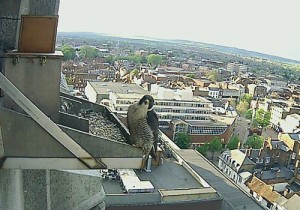Since I wrote the following, the single egg hatched, on Monday, April 28th. The young bird is being fed by its parents now.
http://www.aylesburyperegrine.org.uk/pcam.html —
Aylesbury’s pair of peregrine falcons are tending their first egg on their purpose built nesting platform at the top of the 200 feet high County Hall in the centre of the Bucks town.
It’s still early April, and there is the promise of more eggs to come. This is the third successive year the falcons have nested here, and I don’t think our sense of wonder should diminish.
All round the world, totemic species such as elephants, tigers and polar bears have big habitat problems. We can’t be confident about the survival of any of them. Yet all the fastest bird in the world, the prize of Arabian princes, needs to thrive in Britain is a high man-made structure in a town or city, ideally with pigeons (so that makes it any town or city).
In wildlife-watching terms, walking across, in Aylesbury’s case, Market Square, or sitting on a bench in front of the new Waitrose and keeping your eyes trained on the sky around the tower, is akin to sitting in a Land Rover on the Serengeti watching a hunting lioness.
In one depressing respect, it’s better. While we don’t know what is going to become of Africa’s wide open spaces, and wildlife, over the years, it is hard to see our urban landscape becoming much less accommodating for the peregrine.
Does the bird deserve the elite status I confer on it? Most certainly. The consensus among the experts is that Falco peregrinus is the world’s fastest bird, indeed the fastest creature on earth. When freefalling onto prospective prey in a stoop, it can reach speeds of upwards of 186mph (300km/h, or 83.3m/s). In one Internet entry, Speed of the Fastest bird, Chris Santoro describes it as “quite possibly the most efficient of all predators.” (The fastest bird in powered flight is thought to be the common swift, Apus apus, which can power itself to 69.3mph (111.6km/h) flying horizontally and even upwards (Journal of Avian Biology, 2010).
To see the Aylesbury peregrines, without much difficulty, and without the need for binoculars, coming in going from their conspicuous but impregnable nest, and occasionally zipping out at warp speed to terrorise the skies over this small market town is a great privilege and thrill.
This year (2014) the birds have a new platform, donated by Serco and RAF Halton. The project’s supporters include Aylesbury Vale District Council, Buckinghamshire County Council, Bucks Bird Club and the Berkshire, Buckinghamshire & Oxfordshire Wildlife Trust.
Peregrines were first observed regularly in Aylesbury in 2006 and in 2008 a nesting platform was placed at the top of county hall. The birds first bred successfully in 2012 and have hatched young every season since. In 2012 officers from Aylesbury Vale Council and Bucks CC spoke about the project at an international conference. Successful peregrine nesting projects are taking place in a number of British towns and cities in 2012, in most cases using nest boxes fixed to high old buildings such as churches and cathedrals.
See more at http://www.aylesburyperegrine.org.uk/pcam.html

